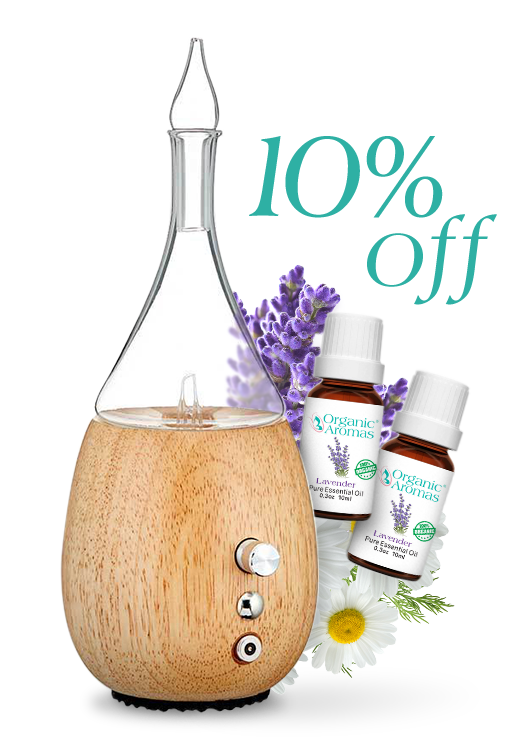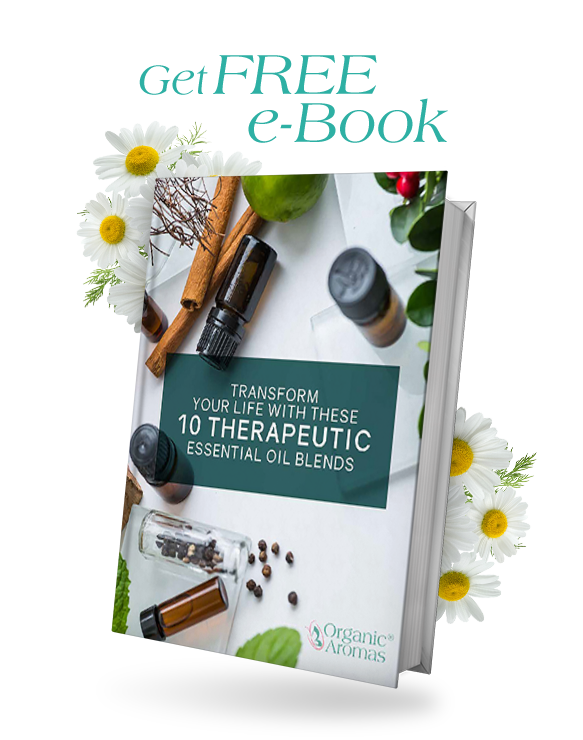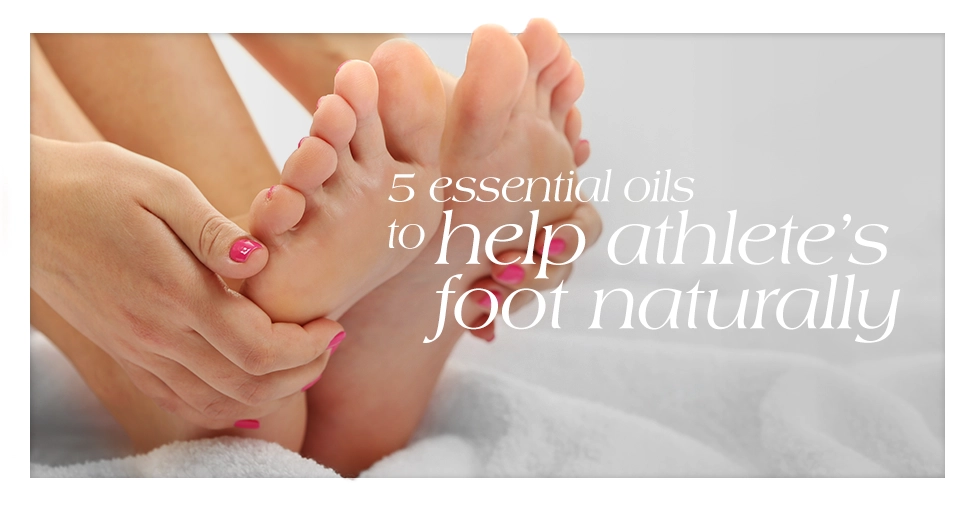5 Essential Oils to Help Athlete’s Foot Naturally
Welcome to our comprehensive guide where we dive into the natural world of the best essential oils to combat the pesky condition known as athlete’s foot. While this fungal foe can cause discomfort and irritation, nature offers us a powerful toolkit for relief and prevention. Before we march forward, a quick nod to the wise: this article is for informational purposes only and not a substitute for professional medical advice.
Key Takeaways
What is Athlete’s Foot

Athlete’s foot, medically known as tinea pedis, is a fungal infection caused primarily by dermatophytes, a type of fungi. These fungi thrive in warm, moist environments, making the human foot, especially the area between the toes, an ideal breeding ground. The infection can cause a scaly rash that leads to itching, stinging, and burning sensations.
Dermatophytes are Categorized into Three Genera
- Trichophyton – This genus is responsible for most types of dermatophyte infections, including athlete’s foot, jock itch, and infections of the nails (onychomycosis).
- Microsporum – These fungi primarily affect the skin and hair.
- Epidermophyton – This genus is known to cause skin and nail infections, particularly athlete’s foot and jock itch, but does not affect the hair.
What Factors Contribute to the Development of Fungal Infections
- Warm, Moist Environments: Dermatophytes flourish in warm, damp conditions. Places like public showers, swimming pools, and locker rooms can be hotspots for contracting the fungus due to the high humidity and the presence of many bare feet.
- Direct Contact: Athlete’s foot is contagious and can be spread through direct contact with an infected person or by touching surfaces contaminated with the fungus, such as towels, floors, and shoes.
- Sweaty Feet: Wearing tight-fitting shoes and socks that don’t allow feet to breathe can create a sweaty environment conducive to fungal growth.
- Compromised Immune System: Individuals with weakened immune systems are more susceptible to fungal infections, including athlete’s foot.
- Minor Skin or Nail Injuries: Cuts or abrasions on the feet can provide an entry point for fungi, increasing the risk of infection.

Sign Up to Get Your FREE
e-Book Here…
Is Athlete’s Foot Contagious
Dermatophyte infections are contagious and can be spread through direct contact with infected individuals or animals, or indirectly through contact with contaminated objects (such as towels, clothing, and floors). The fungi thrive in warm, moist environments, making communal showers, locker rooms, and swimming pools common places for infection transmission.
he Science Behind Essential Oils for Athlete’s Foot
The science behind using essential oils to treat athlete’s foot centers around their natural antifungal properties. Essential oils are concentrated plant extracts that retain the natural smell and flavor, or “essence,” of their source. These oils are composed of various chemical constituents that can provide therapeutic benefits, including antifungal activity. Here’s a closer look at the scientific principles underlying their effectiveness against athlete’s foot:
Antifungal Compounds
- Terpenes and Terpenoids: Many essential oils contain terpenes (e.g., limonene, pinene) and terpenoids, which have been shown to disrupt the cell membranes of fungi, leading to cell death.
- Phenolic Compounds: Phenols (e.g., carvacrol, thymol) are known for their strong antifungal and antibacterial properties. They can act on fungal cells by damaging cellular structures and interfering with their metabolism.
- Alcohols: Certain alcohols found in essential oils, such as linalool and geraniol, possess antifungal effects by disrupting the integrity of fungal cell membranes.
Antifungal Activity
- Cell Membrane Disruption: The bioactive compounds in essential oils can integrate into the fungal cell membrane, causing increased permeability and leakage of vital cell components, ultimately leading to cell death.
- Inhibition of Cell Growth and Reproduction: Essential oils can interfere with the replication process of fungal cells, preventing them from spreading and causing further infection.
- Interference with Fungal Metabolism: Some compounds in essential oils can inhibit the activity of enzymes crucial for fungal metabolism, disrupting their energy production and growth.
- Reduction of Inflammation: Essential oils like tea tree oil also exhibit anti-inflammatory properties that can help alleviate the discomfort associated with athlete’s foot, such as itching and burning.
Research and Efficacy
Numerous studies have investigated the antifungal properties of essential oils, with many highlighting their effectiveness against dermatophytes, the fungi responsible for athlete’s foot. For example, tea tree oil has been extensively studied and is noted for its ability to treat various fungal infections, including athlete’s foot, due to its compound terpinen-4-ol, among others. Similarly, eucalyptus, peppermint, and lavender oils have shown antifungal activity in laboratory settings.
Key Essential Oils for Athlete’s Foot

Tea Tree Essential Oil
Originating from the Lamiaceae family, tea tree oil is renowned for its potent antifungal and antimicrobial properties, thanks to the active ingredient terpinen-4-ol. This compound is the heavy hitter in tea tree oil’s treatment against fungi, effectively disrupting the cell membranes of the fungi responsible for athlete’s foot. Its ability to penetrate the skin and reach deeper fungal infections makes it a powerful remedy. Additionally, tea tree oil has been subject to numerous studies confirming its efficacy in treating various fungal foot conditions, making it a go-to choice for those seeking natural antifungal options.
Lemon Essential Oil
Lemon essential oil, with its bright and acidic profile, offers more than just a refreshing scent—it’s equipped with limonene, a powerful compound known for its antifungal properties. Limonene targets the fungi directly, disrupting their growth and preventing the spread of the infection. Its acidic nature creates an inhospitable environment for fungal survival, effectively acting as a natural antiseptic agent. The invigorating scent of lemon oil also adds an uplifting touch to its therapeutic applications.
Lavender Essential Oil
Lavender oil, widely appreciated for its soothing aroma, harbors linalool and linalyl acetate, compounds that grant it significant antifungal abilities. These constituents allow lavender oil to soothe inflamed skin while actively combatting fungal pathogens. The dual action of alleviating discomfort and directly attacking the fungi makes lavender essential oil an excellent option for those seeking relief from athlete’s foot symptoms. Its gentle nature also makes it suitable for sensitive skin, offering a calming experience alongside its significant antifungal effect and benefits.
Eucalyptus Essential Oil
Eucalyptus oil is celebrated for its cooling effect and potent antifungal properties, attributed to the active compound 1,8-cineole (eucalyptol). This component is effective in targeting and eliminating the fungi responsible for athlete’s foot, providing relief from the infection. Eucalyptol has been studied for its antimicrobial activities, showcasing its ability to not only combat fungal infections but also soothe inflammation, making it a versatile essential oil for treating athlete’s foot.
Peppermint Essential Oil
Peppermint oil offers a refreshing respite for feet afflicted with athlete’s foot, largely due to the presence of menthol, its active antifungal ingredient. Menthol contributes to peppermint oil’s cooling sensation, which can alleviate itching and discomfort, while its antifungal properties work to eradicate the infection. The invigorating effect of peppermint oil on the skin promotes a sense of freshness and relief, making it a popular choice for foot care routines aimed at combating fungal growth.
Geranium Essential Oil
Geranium oil, a floral powerhouse, supports skin health and fights fungal infections with grace and efficacy. The active compounds geraniol and citronellol endow it with its antifungal prowess, enabling it to target and disrupt fungal cells effectively. These components, combined with geranium oil’s ability to enhance skin regeneration and balance, make it an excellent natural remedy for not only treating athlete’s foot but also for promoting healthy, resilient skin.
Lemongrass Essential Oil
Lemongrass oil, with its zesty and invigorating essence, acts as a formidable opponent against fungal infections, courtesy of citral, its primary antifungal agent. Citral is known for its ability to inhibit fungal infection and proliferation, offering a serious combination of natural and efficient means of combating athlete’s foot. Lemongrass oil has strong antimicrobial and antiseptic properties further enhance its effectiveness as a natural remedy, providing a citrusy shield that not only fights the fungus but also revitalizes the skin and senses.

How to Use Essential Oils for Athlete’s Foot
Using essential oils as a treatment for athlete’s foot can be highly effective when done properly. The antifungal properties of these oils can help alleviate symptoms and combat the underlying fungus. Here’s how you can use essential oils through different methods while ensuring safety and effectiveness:
1. Preparing Your Feet
The first step in any treatment is preparation. Thoroughly wash your feet with soap and warm water, paying special attention to the spaces between your toes. Dry your feet completely, as moisture is a breeding ground for fungi. This step is crucial to make the treatment more effective.
2. Soothing Foot Soak
A foot bath or soak can provide a widespread antifungal treatment while also being incredibly relaxing.
- Ingredients: Fill a basin with warm water and add a few drops of your chosen essential oils such as tea tree oil or lavender oil. You might consider the Athlete’s Foot Blend Recipe or simply use tea tree and lavender oil for their potent antifungal and soothing properties for your foot soak.
- Method: Soak your feet for about 15-20 minutes, allowing the essential oils to penetrate the affected areas. Pat your feet dry thoroughly after the foot soak.
- Frequency: Once daily, preferably in the evening to relax the feet after a day’s activities.

Join Now and Get a Coupon for 10% Off!
3. Applying with a Compress
For targeted treatment, especially for specific areas of affected skin that are more affected, a compress can be very effective.
- Ingredients: Add a few drops of essential oils such as tea tree oil or eucalyptus oil to a bowl of warm water. Soak a clean cloth or gauze in the pure solution.
- Method: Wring out the excess water and apply the cloth or gauze to the affected area for about 15-30 minutes. Ensure the compress is warm but not uncomfortably hot.
- Frequency: Do this 1-2 times daily, depending on the severity of the infection.
4. Direct Massage with Carrier Oil
Direct application through massage helps in deeper penetration of the oils into the foot, providing relief and aiding the body in the healing process.
- Ingredients: Dilute a few drops of tea tree oil with a carrier oil such as coconut oil, almond oil, or jojoba oil. The dilution is crucial to prevent any irritation or sensitization.
- Method: Gently massage the oil mixture onto the affected area, ensuring full coverage. Focus on dry and cracked areas, which are more susceptible to fungal infiltration.
- Frequency: Apply 2-3 times daily, with one application preferably before bedtime to allow the oils to work overnight.
6. Aftercare
After applying essential oils, wear clean, breathable socks to protect your feet and to prevent any potential transfer of the oil to other surfaces or materials. Avoid tight-fitting shoes that can exacerbate sweating and moisture retention. Consistency is key in seeing results.
Athlete’s Foot Blend Recipe

Creating a blend of essential oils for treating athlete’s foot can provide a synergistic approach that leverages the unique antifungal properties of each oil. Below is a carefully crafted recipe designed to harness the power of the several essential oils that we’ve discussed. This blend aims to soothe the foot, reduce fungal activity, and offer a refreshing and healing experience. Remember, it’s important to dilute essential oils properly with a carrier oil to minimize any risk of skin irritation.
Ingredients:
- Tea Tree Essential Oil: 10 drops (antifungal powerhouse)
- Lavender Essential Oil: 8 drops (soothing and antifungal)
- Eucalyptus Essential Oil: 5 drops (cooling and antifungal)
- Peppermint Essential Oil: 5 drops (cooling and refreshing)
- Lemon Essential Oil: 5 drops (antifungal and refreshing)
- Geranium Essential Oil: 5 drops (skin health support)
- Lemongrass Essential Oil: 2 drops (strong antifungal)
- Carrier Oil: 30 mL (e.g., coconut oil, jojoba oil, or almond oil)
Instructions:
- Prepare Your Blend Container: Choose a clean, dark glass bottle to mix and store your essential oil blend. A dark bottle helps to protect the oils from light degradation.
- Mix Essential Oils: Carefully add the specified drops of each essential oil to the bottle. Use a dropper for accuracy to ensure you get the right amount of each oil.
- Add Carrier Oil: Fill the rest of the bottle with your chosen carrier oil up to the 30 mL mark. The carrier oil dilutes the essential oils to a safe concentration for skin application and helps to spread them more easily.
- Blend Thoroughly: Secure the bottle cap and gently roll the bottle between your hands for a few minutes to mix the essential oils with the carrier oil thoroughly. Avoid vigorous shaking to prevent creating air bubbles.
- Label Your Blend: Label your bottle with the name of the blend and the date of creation for future reference.
- Patch Test: Before applying the blend extensively, perform a patch test on a small area of foot to ensure there’s no adverse reaction.
- Application: To use, apply a small amount of the blend to the affected area 2-3 times daily. Ensure the feet are clean and dry before application. Avoid applying between the toes where moisture can be trapped.
- Storage: Store the blend in a cool, dark place when not in use to preserve its therapeutic properties.

Sign Up to Get Your FREE Essential Oils e-Book Here
Prevention is Better than the Cure: Tips to Preventing Athlete’s Foot
Preventing athlete’s foot is largely about maintaining good foot hygiene and minimizing exposure to the fungus. Here are practical tips to avoid this uncomfortable condition:
Keep Feet Dry and Clean – Wash your feet daily with soap and water. Make sure to dry them thoroughly, especially between the toes where moisture can easily get trapped creating unpleasant odor.
Change Socks Regularly – Wear clean socks daily, or change them more often if your feet get sweaty. Choose socks made of materials that wick moisture away from the skin, such as wool, bamboo, or synthetic blends designed for athletes.
Wear Breathable Footwear – Opt for shoes made from materials that allow your feet to breathe, like leather or canvas. Avoid wearing plastic shoes or those made from other non-breathable materials for prolonged periods.
Protect Your Feet in Public Areas – Wear sandals or flip-flops in public showers, locker rooms, and around pools. These areas are breeding grounds for the fungi that cause athlete’s foot.
Alternate Shoes – Give your shoes time to air out by not wearing the same pair two days in a row. Using a shoe dryer or placing shoes in a well-ventilated area can help reduce moisture.
Use Antifungal Powders or Sprays – Regularly apply an antifungal powder or spray to provide relief for your feet and inside your shoes to kill any lingering fungi. This is especially useful in warmer months when feet tend to sweat more.
Maintain a Healthy Skin Barrier – Use moisturizers to keep the skin on your feet supple and prevent cracks. Fungi can enter through small cracks in the skin, leading to infections.
Manage Sweat – If you have sweaty feet, consider using specialized insoles that absorb moisture, applying antiperspirant to the soles of your feet, or changing socks throughout the day.
Educate Yourself and Others – Knowing how athlete’s foot spreads can help you take steps to prevent it and educate others. Encourage family members to follow preventive measures to manage fungal condition, especially if someone in the household has been infected.
Healthy Lifestyle – A healthy immune system can fend off infections more effectively. Maintain a balanced diet, get adequate sleep, manage stress, and exercise regularly to boost your overall health.
Safety and Considerations for Using Essential Oils on Athlete’s Foot
When incorporating essential oils into your treatment plan for athlete’s foot, prioritizing safety is paramount. Below are key guidelines to ensure a safe and effective application:
- Dilution Is Crucial: Essential oils are highly concentrated and can cause skin irritation or allergic reactions if applied directly to the skin without a carrier oil. Dilute essential oils with a carrier oil like coconut, jojoba, or almond oil before application. A general rule of thumb for skin applications is a 2-5% dilution rate, equivalent to about 12-30 drops of essential oil per ounce (30 mL) of carrier oil.
- Patch Test: Before using a new oil or oil blend, perform a patch test. Apply a small amount of the diluted essential oil to a discreet area of skin and wait 24 hours to observe any adverse reactions. This step helps to identify potential sensitivities or allergies.
- Use Quality Oils: Ensure the essential oils you use are of high quality and from reputable sources. Purity and composition can vary widely between brands, affecting the oil’s safety and effectiveness.
- Consider Health Conditions: Pregnant women, nursing mothers, and individuals with existing health conditions or sensitive skin should consult with a healthcare professional before using essential oils. Certain oils may have contraindications with specific health conditions or medications.
- Avoid Sensitive Areas: When applying essential oils, avoid sensitive areas such as near the eyes, inner ears, and any broken or severely irritated skin. Essential oils can be potent, and contact with these areas can cause irritation.
- Storage and Usage: Store essential oils out of reach of children and pets, and follow the specific oil’s guidelines for storage, typically in a cool, dark place. Proper storage extends the efficacy and shelf life of the oils.
- Footwear and Hygiene: In addition to using essential oils, wear breathable footwear and maintain good foot hygiene to prevent the conditions that allow athlete’s foot to thrive. Keeping feet dry and clean is essential in combating fungal infections.
- Professional Advice: If your athlete’s foot condition persists or worsens despite treatment, or if you experience significant skin reactions, seek professional medical advice. Essential oils are complementary treatments and may not substitute for prescribed medications or professional medical interventions for severe cases.

Join Our Exclusive Member Club to get Big Discounts!
Conclusion
Using essential oil to treat athlete’s foot, with tea tree oil leading the charge, stand as a testament to the power of natural remedies in our ongoing battle against this condition By embracing these oils, especially the potent antifungal properties of tea tree, not only do we tread a path toward healing but we also step closer to harmony with nature Remember, consistency in applying these natural solutions and adhering to preventive measures go hand in hand with effective treatment Should your condition persist or worsen, seeking professional medical advice is crucial Here’s to happy, healthy feet
Embarking on this aromatic journey not only educates but also empowers us to take control of our health using essential oil to treat athlete’s foot, with tea tree oil as a prime example of nature’s efficacy Dive into the world of essential oils, led by the remarkable tea tree, and bid farewell to athlete’s foot with a natural, refreshing step forward
Frequently Asked Questions (FAQs)
What Essential Oil is Best for Athlete’s Foot?
Tea Tree Essential Oil is widely regarded as one of the best for treating athlete’s foot due to its powerful antifungal and antiseptic properties. Tea Tree has been extensively researched and shown to effectively combat the fungi responsible for athlete’s foot.
Which Essential Oil is the Strongest Antifungal?
While several essential oils have strong antifungal properties, Oregano Essential Oil is often cited as one of the strongest due to its high content of carvacrol, a compound known for its potent antifungal activity.
How Effective Are Essential Oils in Treating Athlete’s Foot?
Essential oils can be highly effective in treating athlete’s foot for many individuals. Their antifungal properties have been confirmed in various studies, with tea tree essential oil, in particular, showing comparable results to over-the-counter antifungal treatments in some cases.
Can Athlete’s Foot Be Treated at Home?
Yes, athlete’s foot can often be successfully treated at home with proper care and treatment methods, including the use of essential oil such as tea tree oil, over-the-counter antifungal medications, and maintaining good foot hygiene.
What is the best method to treat Athlete’s Foot?
The best method using essential oils to treat athlete’s foot involves applying a blend of antifungal essential oils, such as tea tree oil, lavender oil, and eucalyptus oil, diluted in a carrier oil directly to the clean, dry affected area daily.




Very interesting.
Great Informative Post about essential oils. Best 4 Your Home
Great post! Thank you for sharing. Check also this essential oil
Aromatherapy and Essential Oil is really good for the Skin because of many Nutrients Enveloped on it. Certified Massage Therapist
I love essential oils and use them daily. Thank you for your insight.
Can olive oil help athletic foot
Can I add tea tree oil to a lotion to apply to my feet for relief from athletes foot?
What would you recommend for applying to feet in a roller to help with feet from dryness and itching
Great post! Can I use these remedies on my two year old?
Hy! My name is Simran. I read your post thoroughly. I am also a blogger and I really really like your post. It’s a great niche. You know what it is very beneficial for all Athlete’s Foot patient. Thanks 4 sharing this post. Carry on, Best of luck.Have a nice future.
Thank you for such Great information regarding natural products and solutions that can help with problems like this because now since it’s Spring we want to see some healthy feet and body. Love your Blog info.
Have tried so many things and nothing seems to be working. going to try now with your suggestions of combination of oils and see if that helps. Tea tree oil is amazing!
Love tea trea oil . My husband use it all the time on his nails.
It was a great discovery how wide the potential field of usage of essential oils are. At the beginning it was only about fragrance for me. Now we use the oils to keep all members of our family in good shape…
I’m glad I don’t have this problem. I do love what essential oils can do.
Very interesting! I’m just getting started with essential oils.
Thankfully I haven’t had to deal with this yet, but I’ll keep this in mind if I ever need it!
I can truly attest to the fact that tea tree oil will definitely help with Athlete’s foot and even plain old foot stink!
Great info! Essential oils are wonderful. I use them daily.
The more I read about essential oils, the more impressed I am at how it can help so many conditions.
I have been a lucky person never had this problem. But I know several people that have it so will be forwarding link to them